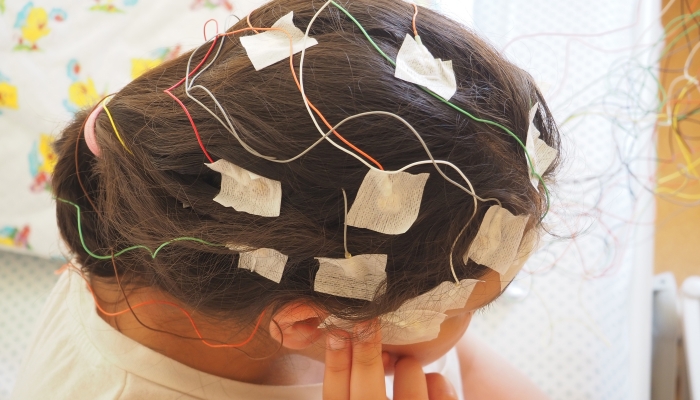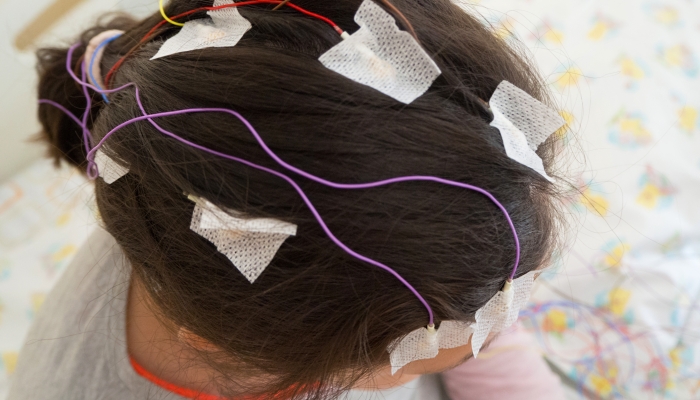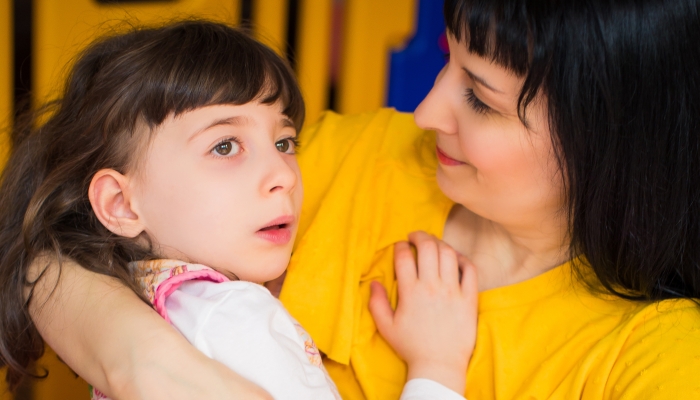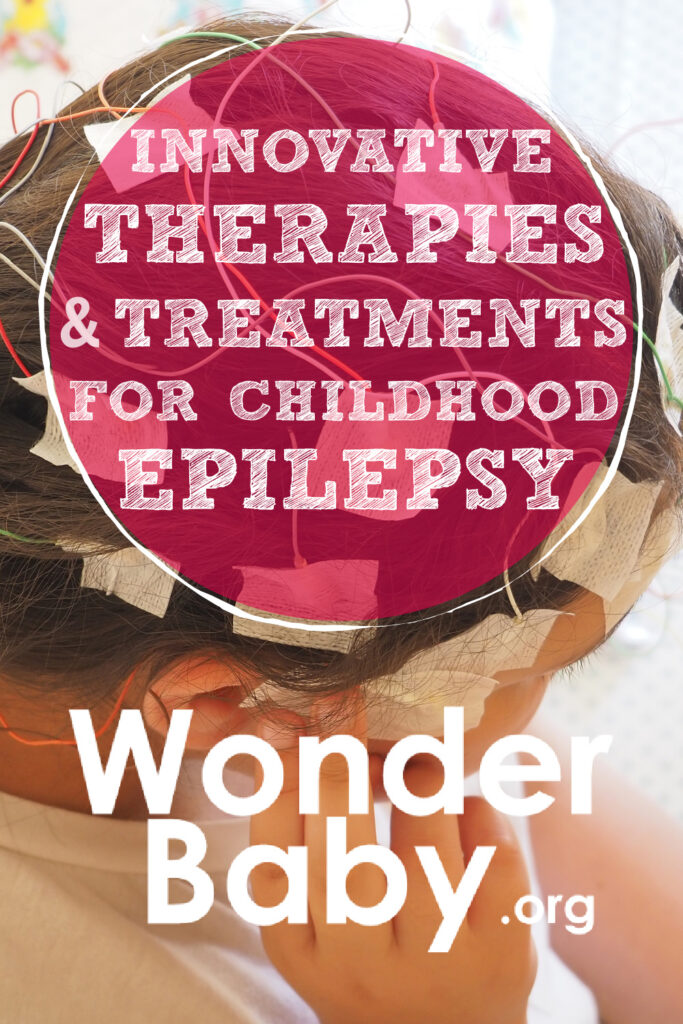Innovative Therapies and Treatments for Childhood Epilepsy

- Childhood epilepsy is typically treated with anti-seizure medication.
- When more than two medications have failed to control seizures, neurologists may recommend innovative treatments and therapies.
- Innovative treatments include diet changes, deep brain and vagal nerve stimulators, and brain surgery.
- Innovative therapies have been shown to improve symptoms for most children with epilepsy.
If you’ve ever had a seizure or have seen someone else have one, you know how scary it can be. Parents of children with epilepsy face many challenges and may constantly worry about their child’s future. If your child has gotten an epilepsy diagnosis, chances are you’ve heard about traditional methods for seizure control like anti-seizure medications.
Many pediatric neurologists also recommend non-traditional therapies to control seizures and improve the quality of life for patients and their families. Pediatric epilepsy is a scary condition, but treatment options continue to improve as scientists and neurologists continue to learn more about brain function and chemistry.
If you want to try something more than just traditional anti-seizure medication, there are some innovative therapies and treatments for childhood epilepsy available.
Understanding Childhood Epilepsy Treatment

Seizures are a complex medical condition that has many different causes. Everything from genetic conditions to low blood sugar levels can cause a seizure.
Childhood epilepsy syndromes are usually diagnosed when a child has recurring seizures. If your child has more than one seizure, they may need to get magnetic resonance imaging (MRI) of their brain, blood tests, and genetic tests to uncover the root cause of their problem.
There are several different types of seizures children can experience:
- Focal seizures. These are also referred to as partial seizures and may involve just one body part or a small part of the brain. If your child is having a focal seizure, you may see just one limb or even one muscle shaking.
- Generalized seizures. These are what are typically portrayed in movies and other media. They are scary-looking seizures that can cause the entire body to tremble and shake uncontrollably.
- Absence seizures. These types of seizures can be difficult to identify. When an absence seizure occurs, it may just look like your child loses focus and stares off into the distance.
Medication for Epilepsy
Anticonvulsant medications are usually used to reduce seizure frequency or prevent a seizure from happening. Usually, a physician will prescribe the lowest dose they can to avoid potential risks associated with the medication.
Most anti-seizure medications work by slowing down nerve impulses. Because of this, many of them cause side effects like drowsiness and lethargy. Some of the most common medications used for seizure control include:
- Levetiracetam
- Lamotrigine
- Gabapentin
- Phenytoin
- Carbamazepine
- Valproic Acid
These medications are usually given on a strict schedule, with some children requiring doses up to six times per day for adequate seizure control. Experts at Johns Hopkins Medicine11. Treatment for Epilepsy & Seizures. Johns Hopkins Medicine. https://www.hopkinsmedicine.org/neurology_neurosurgery/centers_clinics/epilepsy/treatment.html remind parents that it may take some trial and error to find the right medication combination and dosing schedule for your child
Benzodiazepines like Ativan are used in emergencies to stop a seizure while it’s happening. These are usually given rectally since a person experiencing a seizure is unable to swallow medication, and giving an injection to a child having a seizure can be difficult for many parents.
What Innovative Therapies and Treatments Are Available for Childhood Epilepsy?

While medications are often effective for the management of pediatric epilepsy, adding other treatments may improve your child’s seizure control or allow your physician to decrease their medication dosing. Make sure you coordinate closely with your pediatric neurologist while trying to use any of these strategies for controlling seizures.
Dietary Therapies
The ketogenic diet has grown in popularity as a way for adults to rapidly lose weight. However, that wasn’t the original purpose of the ketogenic diet. The ketogenic diet was originally created in the 1920s as a way to control epileptic seizures.
A 2019 study titled “Ketogenic Diet and Epilepsy22. Ułamek-Kozioł, M., Czuczwar, S. J., Januszewski, S., & Pluta, R.. Ketogenic Diet and Epilepsy. Nutrients. 2019;11(10), 2510. https://doi.org/10.3390/nu11102510” and published in the journal Nutrients, shows that the ketogenic diet is highly effective for children with seizures that are not well controlled by medication. Studies have shown that most children experience at least some reduction in seizure activity within the first few months of starting this diet, and some children experience a complete cessation of seizures.
While it does work well, a ketogenic diet is not an easy fix. True ketogenic diets require children to keep their carbohydrate intake below 10% of their total calories, and it can cause side effects like mood swings, constipation, and lethargy.
Parents have to be diligent in making sure that their children consume enough calories, vitamins, fiber, and water while treating epilepsy using a diet.
Vagal Nerve Stimulators
The vagus nerve is a nerve that runs from the brain along the sides of the neck and controls major organ functions like digestion, heart rate, and respiratory rate. You can stimulate your vagus nerve by bearing down as if to have a bowel movement. This vagus nerve stimulation can slow your heart rate and decrease your blood pressure.
For patients with recurrent seizures or epilepsy, vagus nerve stimulation can slow down nerve impulses responsible for seizure activity. Vagal nerve stimulators can prevent seizures, lessen the severity of seizures, or even stop a seizure after it starts.
Most vagus stimulators are placed in the chest, just under the skin. A wire is then threaded from the device to the vagus nerve, where it can send electrical currents up the nerve and to the brainstem. These devices are usually connected to the left vagus nerve to lessen the impact they have on the heart.
Experts at the British Epilepsy Association33. Toffa, D. H., Touma, L., El Meskine, T., Bouthillier, A., & Nguyen, D. K.. Learnings from 30 years of reported efficacy and safety of vagus nerve stimulation (VNS) for epilepsy treatment: A critical review. Seizure. 2020;83, 104–123. https://doi.org/10.1016/j.seizure.2020.09.027 have found that vagal nerve stimulation reaches peak effectiveness about six months after insertion of the stimulating device, and that close to 50% of patients experience at least a 50% reduction in seizure activity.
Epilepsy Surgery
Epilepsy surgery is often considered a last resort for children with epilepsy that has not been responsive to medication, dietary changes, or vagus nerve stimulation. It is generally only used for patients who have seizure activity that always originates in the same area of the brain.
According to the Mayo Clinic44. Mayo Clinic Staff. Epilepsy surgery. Mayo Clinic. 2022. https://www.mayoclinic.org/tests-procedures/epilepsy-surgery/about/pac-20393981, there are several different types of epilepsy surgery. Each of these surgeries has the potential to cause problems with cognition and memory, personality changes, loss of sensation or movement, and even death.
Resective Surgery
Resective surgery is the most commonly performed surgery for the treatment of epilepsy. This surgery requires the removal of a small portion of the brain where seizure activity occurs. Usually, the surgeon removes a malformation, area of brain injury or tumor from the problematic area.
Laser Interstitial Thermal Therapy (LITT)
LITT is when a laser is used in place of resective surgery. This type of therapy uses magnetic resonance imaging to identify where seizures are occurring in the brain, and guide a laser used to destroy the offending brain tissue. While this is a less invasive option, there are still significant risks involved.
Deep Brain Stimulation
Deep brain stimulation helps treat epilepsy in children by sending electrical impulses to a specific area of the brain. Similarly to LITT, the doctor uses MRI to place a device inside the area of the brain where seizures are originating. Using a deep brain stimulator is most effective for focal seizure types.
Corpus Callosotomy
Corpus callosotomy removes the nerves of the brain that connect the right and left sides. This treatment is effective for the treatment of seizure activity that starts on one side and moves to the other, or global seizures that affect the whole body.
This procedure can affect vision, balance, speech, and memory.
Hemispherectomy
A hemispherectomy is one of the most invasive and risky surgeries for seizure treatment. Hemispherectomies require an entire section of the brain to be removed and are only performed in severe cases. Usually, a hemispherectomy is performed on very young children.
A child who undergoes a hemispherectomy will need intense occupational, physical, and speech therapies after they leave the hospital. Each child will respond differently to this procedure.
Benefits vs. Risks of Innovative Therapies for Childhood Epilepsy

There are risks and benefits associated will all types of innovative therapies for childhood epilepsy. Whether you try a ketogenic diet, vagal nerve stimulator, or brain surgery, you will need to communicate well with your child’s care team including neurologist, pediatrician, and therapists.
Benefits
Obviously, the goal of these therapies is to stop or reduce seizure activity for your child. These therapies are mostly used to treat children when medications fail to control electrical activity in the brain.
Most children who use innovative treatments experience:
- Fewer seizures
- Less intense seizures
- Shorter seizures
- Reduction in medication use
Risks
While these treatments are effective in treating and preventing seizures, there are some risks to keep in mind.
Children using a ketogenic or modified Atkins diet may experience:
- Constipation
- Weight loss
- Mood swings
- Lethargy
Children who need implantable medical devices or brain surgery may experience:
- Loss of sensation
- Loss of motor skills
- Memory problems
- Problems with cognition
- Decreased balance and coordination
How Long Will It Take to See Results From Innovative Therapies and Treatments?
It’s nearly impossible to guess which strategies will work to control seizures in your child. Some medications and treatments may start to work right away, while others may take weeks or even months to make a difference. Creating a treatment plan for your child takes a lot of trial and error and a lot of patience.
What Can You Do to Support Your Child’s Treatment Process?

Whether you rely primarily on medication, a ketogenic diet, vagal nerve stimulators, or are planning on brain surgery, open communication with your child’s care team is essential.
Try to keep a journal of your child’s seizures, including what happened just before the seizure, the length and type of seizure they experienced, and any details you can remember surrounding the event. Let your child’s doctor know if you notice any changes in their seizure patterns or any negative side effects your child experiences.
Between finding a pediatric epileptologist, looking into clinical trials, visiting epilepsy centers, and exploring treatment options, take any moment you can to enjoy spending time with your child. Just because your child is diagnosed with epilepsy does not mean that they cannot have a happy life or build relationships with family members.
Taking Care of Yourself
Coping with epilepsy in children can be a challenge for the entire family.
In addition to keeping track of medications, journaling about seizure patterns, and communicating with physicians, make sure you are taking time to care for yourself and find moments to enjoy spending time with your child.
Frequent seizures are hard on a parent or primary caregiver, and creating and following a treatment plan can be all-consuming. While it may sound silly or unrealistic, caring for yourself is one of the best ways you will be able to improve the care of your child.
FAQs
How can I determine if an innovative treatment is right for my child’s specific type of epilepsy?
If your child has been diagnosed with epilepsy and has been unresponsive to at least two medications, it may be time to add innovative treatments to your child’s care plan. Seizures that are unresponsive or only partially responsive to medication often do respond to diet, medical devices, or surgery.
Will health insurance cover the cost of innovative therapies and treatments for childhood epilepsy?
While most insurance companies will cover the cost of implantable vagus nerve stimulators and brain surgery, your child may need to meet certain criteria before coverage will kick in. To ensure you have coverage for more invasive procedures, make sure you have an accurate diagnosis, a record of other medications that have failed, and a detailed medical history to submit to your insurance company.
The cost of food for a ketogenic diet will not typically be covered by insurance, but you may be able to use money from a health savings account to buy food and supplements.
References
- Treatment for Epilepsy & Seizures. Johns Hopkins Medicine. (n.d.). https://www.hopkinsmedicine.org/neurology_neurosurgery/centers_clinics/epilepsy/treatment.html
- Ułamek-Kozioł, M., Czuczwar, S. J., Januszewski, S., & Pluta, R. (2019). Ketogenic Diet and Epilepsy. Nutrients, 11(10), 2510. https://doi.org/10.3390/nu11102510
- Toffa, D. H., Touma, L., El Meskine, T., Bouthillier, A., & Nguyen, D. K. (2020). Learnings from 30 years of reported efficacy and safety of vagus nerve stimulation (VNS) for epilepsy treatment: A critical review. Seizure, 83, 104–123. https://doi.org/10.1016/j.seizure.2020.09.027
- Mayo Clinic Staff. (2022, October 21). Epilepsy surgery. Mayo Clinic. https://www.mayoclinic.org/tests-procedures/epilepsy-surgery/about/pac-20393981

The information WonderBaby provides is not intended to be, and does not constitute, medical or other health advice or diagnosis and should not be used as such. Always consult with a qualified medical professional about your specific circumstances.
Related Posts

Eye Conditions and Syndromes, Visual Impairment
Neuralink Announces Plans to Restore Sight to the Blind with Brain Chip
Elon Musk’s company Neuralink has announced plans to begin human trials of its new “Blindsight” brain chip by the end of 2025.

Health & Nutrition
Can Baby Skin Care Products Expire?
Is that forgotten tube of diaper rash cream still safe to use? Learn more about the expiration dates of popular skin care products for infants.

Health & Nutrition
Boosting Immunity in Kids: 3 Tips for a Healthy Winter
Parents can help boost their kids’ immunity during cold and flu season by maintaining healthy eating, sleeping, and exercising habits in the winter.